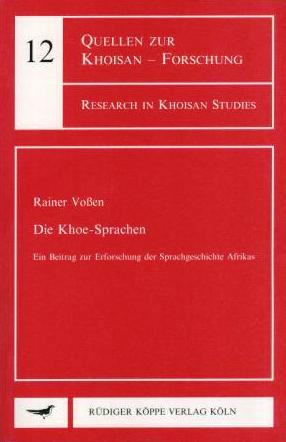

Die Khoe-Sprachen
Ein Beitrag zur Erforschung der Sprachgeschichte Afrikas
Author: Rainer Voßen. Series edited by: Rainer Voßen.
Series: QKF Research in Khoisan Studies Volume 12
1997536 pp.
5 maps, 2 graphs, numerous tables
Text language(s): German
Format: 160 x 240 mm
920 g
Paperback
€ 98.00
Buy 'Die Khoe-Sprachen' as a downloadable PDF document directly from our online shop »
Order 'Die Khoe-Sprachen' as print edition »
Following a contested hypothesis, the Khoe languages form one out of three South African Khoisan languages. Together with the East African remnant languages Sandawe and Hadza they constitute the base of the Khoisan language group. The designation Khoisan replaces the outdated terms Bushman and Hottentot. Today, the Khoe family comprises about 25–30 languages and dialects, spoken mainly in Namibia and Botswana by roughly 230,000 people.
By far the largest and best studied Khoe language is Nama which is spoken in Namibia – most of the other languages have only between 400 and 10,000 speakers respectively, some of them are endangered. The Northeastern Namibian languages Nama and Kxoe not taken into account, not much is known about the other languages of the group till today.
The present book primarily aims at reconstructing the history of development of Khoe languages. Separated regarding phonology and morpology, the 18 languages which are dealt with are first basically described and are afterwards historically compared.
The present work presents a lot of linguistic material, so far unknown to the public, and until now, it represents the only systematic comparative study within the domain of Khoisan languages.
Following the links below you will find proceedings volumes and festschrifts edited by the author:
Accompanying material:
- „Mehr als nur Worte ...”
(ISBN 978-3-89645-125-5 ) - Linguistics across Africa
(ISBN 978-3-89645-510-9 ) - Lone Tree – Scholarship in the Service of the Koon
(ISBN 978-3-89645-227-6 )
Cross-reference:
- Khoisan Languages and Linguistics – 1st Symposium 2003
(ISBN 978-3-89645-864-3 ) - Khoisan Languages and Linguistics – 2nd Symposium 2006
(ISBN 978-3-89645-150-7 ) - Khoisan Languages and Linguistics – 3rd Symposium 2008
(ISBN 978-3-89645-873-5 ) - Khoisan Languages and Linguistics – 4th Symposium 2011
(ISBN 978-3-89645-880-3 ) - Khoisan Languages and Linguistics – 5th Symposium 2014
(ISBN 978-3-89645-878-0 )
Reviews
One of the merits this work has is that the author manages to combine two rather disparate kinds of research situation into a new frame of analysis. The Khoe languages include on the one hand a language like Nama, which has been target of more than a century of intensive research. On the other hand, it also includes more than a dozen languages for which virtually no linguistic information was available prior to Vossen’s field research.
Bernd Heine in Afrikanistische Arbeitspapiere, 53/1998, 127-129
| « back | Print version | [top] |
 Books
Books Audio
Audio Biographies
Biographies Series
Series Festschrifts
Festschrifts Journals
Journals